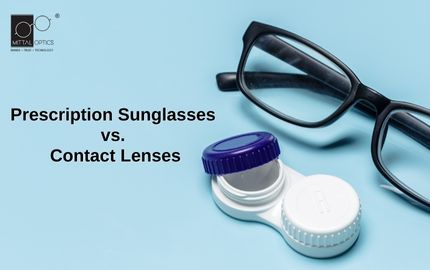Sunglasses are a staple accessory on sunny days, but for those who need vision correction, choosing between prescription sunglasses or contact lenses can be a tough decision. Both have their own sets of pros and cons to weigh when deciding which is best for your eyes and lifestyle. This blog breaks down the key differences between prescription sunglasses and contact lenses to help you make an informed choice.
Visibility and Optical Clarity
When it comes to visibility and optical clarity, prescription sunglasses tend to provide crisper, sharper vision compared to contact lenses. Sunglasses have the benefit of larger lenses that allow more light to enter your eyes, resulting in a wider, more natural field of view with reduced halos or glare around bright lights. The tinting in sunglass lenses also helps reduce eye strain in harsh sunlight.
Contact lenses let ambient light directly into your pupils, which can sometimes cause slight haziness, starbursts, or reduced contrast depending on the type of contact lenses. But newer contact lens technology like photochromic or polarized lenses helps enhance optical clarity, too. Over time, some contact lens wearers can also adapt to the subtle visibility differences as well.
Convenience and Comfort
Both prescription sunglasses and contact lenses provide UV protection for your eyes, but contact lenses tend to offer more versatility and convenience by freeing you from a bulky pair of glasses. Contact lenses move with your eyes naturally without needing adjustments, while sunglasses can slide down your nose or feel heavy after prolonged wear.
That said, some people find contact lenses uncomfortable or irritating to the eyes after many hours of wear. Contact lenses also require maintenance, like cleaning and storage solutions to prevent infections. So, those with sensitive eyes might still prefer the comfort of prescription sunglasses over contact lenses.
Cost Differences
When examining the costs over time, contact lenses usually end up costing more than prescription sunglasses. The initial investment for contact lens fittings and exam fees, followed by the recurring cost of new contact lenses and cleaning supplies, makes them typically pricier than a one-time pair of prescription sunglasses. Sunglasses also last 1-2 years with proper care.
However, wearing prescription sunglasses still incurs some ongoing costs, like scratches or breakages that require replacement lenses or frames. So, you need to weigh the convenience and consistency of sunglasses against the higher but more flexible costs of contact lenses in the long run.
Sport and Outdoor Performance
If you lead an active lifestyle, contact lenses tend to be the better choice for sports and outdoor activities. Contact lenses move freely when you do and won’t slide around like sunglasses, which can be annoying mid-game. Lens fogging is also minimized so you can maintain clear eyesight at all times.
But contact lenses do come with higher risks of losing a lens, developing eye infections, or feeling irritation during sweaty sports compared to sunglasses. Carrying backup glasses is wise if you primarily rely on contact lenses alone. Also, some sport-specific prescription sunglasses are designed to wrap securely around your face, although the additional weight could still hinder performance.
Prescription and Vision Needs
Your exact prescription requirements matter significantly, too when selecting between sunglasses and contact lenses. Those with severe near-sightedness, farsightedness, or focusing issues typically have better visual acuity with prescription sunglasses. The stronger magnification in sunglass lenses compared to contact lenses gives clearer eyesight for those requiring intense vision correction.
But for simpler prescriptions like mild astigmatism or near-sightedness, both sunglasses and contact lenses can effectively correct vision with little noticeable difference in most cases. Still, discussing your needs with an optometrist helps determine if one option might optimize eyesight better in the long term.
Primary Use Cases
How and when you plan on wearing sunglasses or contact lenses should guide your choice. For everyday variable activities, daily contact lenses make managing transitions easier, so you avoid switching between sunglasses and your regular glasses frequently. Contact lenses also offer reliable protection behind the wheel while driving without vision obstructions from glasses slipping.
For recreational activities like boating, fishing, or water sports, polarized sunglasses tend to work better at reducing sun glare off the water. Those needing reading glasses along with sunglasses for close-up tasks may choose prescription sunglasses with bifocals or progressives built in rather than wearing two separate pairs. Figure out your main use cases first before deciding.
The Verdict
When weighing all factors of visibility, convenience, comfort, cost, sports performance, vision needs, and real-world usage –– contact lenses and prescription sunglasses both have excellent yet divergent benefits. Contact lenses optimize mobility and natural sight, while sunglasses offer premium optical clarity and eye protection.
Assessing your vision requirements and planned activities helps determine whether adjustable contact lenses or durable sunglasses suit your lifestyle best. Those needing strong vision correction might benefit most from the stability of prescription sunglasses. But active people who prize versatility commonly prefer the liberation of contact lenses overall despite the higher costs. Either way, both options deliver healthy eye protection while correcting vision effectively if chosen properly.

